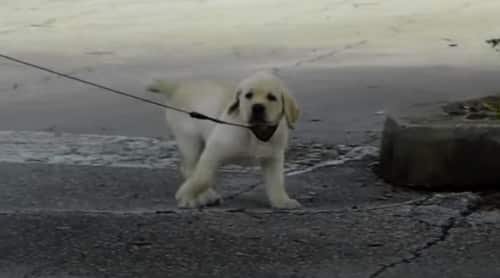If you’ve recently welcomed a labrador puppy into your home (congratulations!) and you don’t have much experience with lab puppies yet, you might have a few questions. The fact that you do only means that you want to do your very best to take care of your pup the best way you can.
You can start walking your lab puppy when they are three months old. Before this age, we mustn’t over-exert our puppies because it might mess with their development. After three months, you can use the five-minute rule to determine how much exercise your lab pup needs.
This article will discuss when your lab pup can start walking, how far a lab puppy can walk, labrador walking problems, how you can get your lab puppy to heel, how to stop your lab from pulling on the leash.
Table of Contents
When Is It Time To Start Walking Your Lab Puppy?
You want the very best for your puppy, and a huge part of their well-being is exercise.
You want to make sure they are getting enough of it but not too much. This section of the article will explain how to handle this the best way you can.
Time To Start Walking
When your Labrador puppy has reached the age of three months, you can generally start walking them.
Before this, they are still very small, and they will get tired relatively quickly, so their playtime is enough for them to use up all of their energy until this age.
How Much Exercise Does A Labrador Puppy Need?
They don’t need any planned exercise for the first three months after their birth because their playfulness during the day will exhaust them enough.
It’s more important to make sure you don’t over-exercise your lab puppy. Over-exertion can damage their development, so be careful not to let your lab puppy play too long with any other dogs you might have.
The Five-Minute Rule
Generally, there is a rule of thumb to make sure you are not over-exerting your puppy or not giving them enough exercise, and that is the five-minute rule.
It works like this: Age in months x 5 = the daily exercise time. So that means if your lab puppy is five months old, you can exercise him for 25 minutes a day (5 x 5).
This doesn’t include their regular playtime but deliberate exercise. Use the five-minute rule up until they’re at least one year old.
Development
As we said before, if you overexert your puppy, you might mess with their development, so you want to make sure that you generally keep the five-minute-rule as a measurement of their exercise.
To get your puppy used to a regular exercise routine, it’s important to start exercising your puppy at three months.
How Far Can a Labrador Puppy Walk?

So, again, your (up to) three-month-old puppy doesn’t need to be walked at all.
They are still in full development, and over-exerting them can only cause harm.
So as soon as your puppy has reached the age of three months, you can slowly start building a walking routine with them!
How Many Miles
An adult human being will walk one mile in about 2000 steps, which takes about 20 minutes if you’re walking at a moderate walking pace.
So for a four-month-old puppy, you can go for about 20 minutes, or if you think it’s easier to think in miles, go for about half a mile.
You want to calculate it into half a mile in this particular example because you’re not walking in a straight line with your lab pup.
Energy Level
If you want to keep a very close eye on the miles or minutes, you’re walking, that’s totally great because you want to do what’s best for your lab puppy!
However, you can also look at your pup and consider how much energy you already feel like they’ve used up and if they seem tired to judge whether or not you can go for five more minutes or if it’s time to head back a little early.
Puppy Play
In addition to the previous paragraph, I would like to add that your lab pup also uses a lot of energy by playing or specific training exercises.
If you are walking them as well, you want to keep in mind that this also contributes to their energy level.
If you brought your pup to your friend who also has one and they’ve played in the garden for an hour, they do not also need a walk.
Labrador Walking Problems
Labradors are prone to hip issues (later on in their lives) such as hip dysplasia; The key is to detect it early so you can work on it. Symptoms of hip dysplasia:
- Stiffness
- Limping
- Sitting like a frog
- Difficulty getting up (from a nap)
- Trouble walking up and down the stairs
If you see any of these symptoms in your labrador, you will have to consult your veterinarian for further consulting.
How Do I Get My Lab Puppy To Heel?
Here are the steps you can take to get your lab puppy to heal:
- Let them start in a ‘sit’ position.
- Keep them on a leash at first, especially important with puppies!
- Start walking a little bit while keeping the leash loose.
- Give your pup a treat and praise them for their good behavior. Then tell them to go into a ‘heel’ position.
- Keep on practicing while walking and saying the command ‘heel’ several times.
- Now you can add some distractions while you’re walking and keep saying the command ‘heel’ now and then.
- If all of this went well, you could let go of the leash and try it again.
- If it is still going well, take the leash off and practice again. Don’t forget to treat them if they are doing well.!
How Do I Stop My Labrador From Pulling When Walking?
It would help if you understood that walking on a leash is not natural/instinctive behavior for (labrador) dogs.
They will try to go in any direction they please, which means you might be dragged along for the ride.
Until labradors become senior dogs, they are playful, excited, and energetic, so they will want to follow their urges and pull on that leash. Luckily, you can unlearn this type of behavior.
Why They Do It
In addition to the reasons I’ve already mentioned why your lab might be pulling the leash, there is more.
It is also good to know that dogs are pack animals where there is a lot of hierarchy, so if they see other dogs, they will want to show other dogs that they’re the alpha dog.
What You Can Do
While putting on the leash, you will have to teach your dog to stay calm in the process.
This might be hard at first since they are so excited to go for a walk, but it’s hard for you to walk them while getting pulled along if they are still in that over-excited state of mind.
As soon as they’ve reached a level of calmness, you can put on the leash and start walking.
Additionally, keep your walks short if your lab is pulling a lot. Practice with short walks, so they don’t get over-excited.
In Conclusion
You can start walking your labrador puppy when they are three months old.
It’s important not to over-exert your lab pup because this might cause some issues with their development.
If they are three months old, you can start walking them while using the five-minute rule up until they’re one year old.
Related Articles
- What Color Are Chocolate Labs At Birth? Fact Not Fiction
 Labradors are immensely popular as pets due to their intelligence, gentle nature, and trainability – they are also very patient with children. Everyone can agree that all Labradors are adorable
Labradors are immensely popular as pets due to their intelligence, gentle nature, and trainability – they are also very patient with children. Everyone can agree that all Labradors are adorable - Is Breeding Labs Profitable? Facts Not Fiction
 Breeding Labradors is a potentially highly profitable market due to the high and constant demand across the world. But to truly make the most of such an endeavor, a breeder must be very thorough with their plans, particularly their budget.
Breeding Labradors is a potentially highly profitable market due to the high and constant demand across the world. But to truly make the most of such an endeavor, a breeder must be very thorough with their plans, particularly their budget. - What Happens When You Breed A Chocolate And Yellow Lab?
 Breeding a chocolate labrador with a yellow labrador can be complicated with unexpected results. There are six possibilities for offspring color combinations, and much depends on the parents’ genotype.
Breeding a chocolate labrador with a yellow labrador can be complicated with unexpected results. There are six possibilities for offspring color combinations, and much depends on the parents’ genotype. - Are Silver Labs Good Hunting Dogs? Myth Debunked
 A silver lab would make a great hunting dog. There are two types of silver labs: English silver labs and American silver labs. While you can try to train either for hunting, the English lab is designed for shows, while the American lab is designed for hunting.
A silver lab would make a great hunting dog. There are two types of silver labs: English silver labs and American silver labs. While you can try to train either for hunting, the English lab is designed for shows, while the American lab is designed for hunting. - What Is The Oldest Age A Labrador Can Have Puppies? Fact Not Fiction
 Eight is the oldest age a labrador female can have puppies; however, most responsible purebred dog breeders will retire a female between five to six years of age. Labradors with health problems or injuries may not be eligible to breed. As a responsible dog owner, you must explore the best breeding practices for your Labrador.
Eight is the oldest age a labrador female can have puppies; however, most responsible purebred dog breeders will retire a female between five to six years of age. Labradors with health problems or injuries may not be eligible to breed. As a responsible dog owner, you must explore the best breeding practices for your Labrador.
